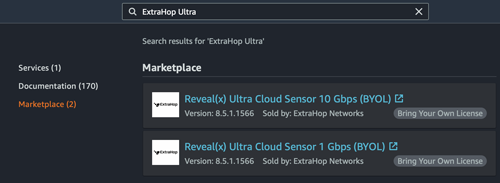Deploy Reveal(x) Ultra in AWS
In this guide, you will learn how to deploy the ExtraHop Reveal(x) Ultra sensor through AWS Marketplace.
System requirements
Make sure you have everything you need to successfully deploy the sensor:
- An AWS account
- An ExtraHop Reveal(x) Ultra license or product key
- A VPC where the sensor will be deployed
- Two ENI subnets. One subnet to access the management interface of the sensor and one subnet that will forward traffic to the sensor
Deploy the sensor
Next steps
- Register your ExtraHop system
- Configure the sensor network interfaces by clicking
Connectivity in the Administration settings. Ensure
that Management Port is selected on Interface 1. For
Interface 2, choose one of the following options:
- For the 1 Gbps sensor, select Management + RPCAP/ERSPAN/VXLAN Target.
- For the 10 Gbps sensor, select High-Performance ERSPAN/VXLAN Target.
Important: If your deployment includes a Command appliance or Reveal(x) 360, the following workflow ensures the best performance for initial device synchronization. First, connect all sensors to the Command appliance or Reveal(x) 360, then configure network traffic forwarding to the sensors. - Complete the recommended procedures in the post-deployment checklist.

Thank you for your feedback. Can we contact you to ask follow up questions?